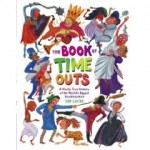 I just started reading Peter Sagal’s The Book of Vice (subtitled very naughty things and how to do them). Sagal offers up this book as a (quasi-satirical?) response to William Bennett and his The Book of Virtues (subtitled a great treasury of moral stories). Bennett wrote his book in 1993 as a response to what he saw as the lack or decline of moral education in the United States. Since I plan to devote several future blog entries to this book (I will end the suspense here: I have many, many problems with Bennett’s book), I will just offer this brief summary: The Book of Virtues is a collection of stories that are meant to educate both children and adults on classic virtues like self-discipline, compassion, courage, responsibility, and honesty. In writing the book in 1993, Bennett hoped to continue the tradition (a tradition that he thinks is being lost) of passing on important values to the next generation.
I just started reading Peter Sagal’s The Book of Vice (subtitled very naughty things and how to do them). Sagal offers up this book as a (quasi-satirical?) response to William Bennett and his The Book of Virtues (subtitled a great treasury of moral stories). Bennett wrote his book in 1993 as a response to what he saw as the lack or decline of moral education in the United States. Since I plan to devote several future blog entries to this book (I will end the suspense here: I have many, many problems with Bennett’s book), I will just offer this brief summary: The Book of Virtues is a collection of stories that are meant to educate both children and adults on classic virtues like self-discipline, compassion, courage, responsibility, and honesty. In writing the book in 1993, Bennett hoped to continue the tradition (a tradition that he thinks is being lost) of passing on important values to the next generation.
I have only read a few pages of Sagal’s book, but I can already tell that it is at least partially a reaction to Bennett and his lofty goal. From the flipped (book of vice not virtue) title, to the strikingly similar book jackets, to Sagal’s gleeful reference to Bennett’s own inability to live up the standards his book promotes, it is clear that Sagal wants to make fun of virtues and virtue talk. He also wants to demonstrate that, even if people think that virtues are a good idea, they really want to talk about and imagine how to practice vice. Here is his (disturbing, I think) assessment of virtues vs. vice:
In the long war between Vice and Virtue, Virtue has been met on the battlefield, routed, defeated in detail, occupied, and reeducated in prison camps. When last seen, Virtue was working on the Strip in Las Vegas, handing out color flyers advertising in-room exotic dancers. She says she’s happy, but she doesn’t meet your eyes (2).
WARNING! WARNING! I see some real problems here. When I first heard about this book, I was intrigued and thought it might offer an interesting counter to the rigid link between virtue and conservative (frequently fundamentalist) thought that is so prevalent these days in popular and scholars-who-don’t-study-religion-or-ethics talk. On some level, I am still hopeful, but I absolutely cannot let this paragraph pass without reacting to Sagal’s satirical take on William Bennett and his virtue crusade. (Wow, this is page 2. How long will it take me to read all 252 pages?)
In Sagal’s scenario, Virtue is a man at battle who is courageously defending the honor of virtues and morals. He is weak and eventually overtaken by Vice. Okay, overtaken is too tame of a word. He is routed, defeated, occupied (violated? penetrated?), and re-educated by Vice (possible translation: Virtue becomes Vice’s bitch?). Having been completely emasculated, he becomes a whore on the street who is so demoralized that she (yes, he is now a she which demonstrates how far he has fallen!) can’t even look you (by the way, who is the you in this sentence?) in the eyes.
Of course, Sagal is joking here and he using his humor to demonstrate (among other things) the hypocrisy of moral crusaders like Bennett and the disconnect between what Bennett (and other “family value” folk) vigorously promote and what they secretly (or not so secretly) practice. I have no problem with exposing such hypocrisy, but I am bothered by how he does it. Let me explain. The image that Sagal gives us here (and as far as I can tell, throughout the book) is exclusively of a white, heterosexual male who must undertake the epic struggle between being virtuous and having vices. Women (of all shapes, sizes, ethnicities, ages) may tempt and successfully seduce him but they are only serve as evidence that the struggle exists. They are not subjects or actors engaging in the struggle themselves.
Now, I understand that Sagal is writing from his own perspective and that he is a white, heterosexual (and happily married) male. And his writing style is one that draws heavily upon his own humorous engagements with and observations of the various vices. For these reasons, I understand why the book would skew toward the white male heterosexual (aka the-top-of-the-heap) demographic. But, in his blurb about virtue and vice in a battle (for our souls) he doesn’t just ignore women, that is, not consider them in his description of the battle. No, he uses them as the foundation for his joke; he uses them to serve up his humor about men who claim to defend virtue but end up (always and inevitably?) being seduced by the dark side and behaving very badly. Ha Ha. Look. Virtue has become a whore. Isn’t that funny? While Bill Bennett and his cronies may be the butt of Sagal’s joke, it is women (and their roles as strippers giving lap dances in the introduction and chapter 3 or as prostitutes handing out flyers) and the reader’s shameful pleasure of them that dominates so much of what I have read so far (since I started this blog entry, I have made it to page 81).
The pitting of women as strippers/whores/objects of our lust against white, heterosexual men as failed paragons of virtue/typical guys-who-want-to-behave-badly is established in the author’s note even before the introduction. Sagal writes about how this book is partly inspired by and dedicated to Marv Albert (and those like him) who engage in vices (Marv is an adulterer who has a secret biting fetish) and get caught. No fair, Sagel cries as he ponders: Why are a select few allowed to get away with it while the rest of us (men, that is) are burdened by our pesky virtues and moral (and legal) accountability to our families and society? Poor Marv, Sagal laments. Basketball players like Wilt Chamberlain and Kobe Bryant can engage in bad, perverse behavior, but a schmo like Marv won’t ever be able to get away with it. He won’t ever be able to engage in polymorphous perversity (or force sex on a woman) and bite a woman (without consent and repeatedly) on her back. Of course, Sagal is not endorsing Bryant’s, Chamberlain’s or Albert’s behavior. But, by not considering the perspective of the women who are the objects of this vice (in this case, sexual perversity and more), Sagal is leaving out an important part of the story about how battles over virtue and vice are engaged (and represented in the popular imagination).
At whose expense is this battle between vice and virtue waged? Whose souls are being struggled over (and who doesn’t have a soul or at least one worth fighting for)? And, why, no matter who wins (Virtue or Vice), does the woman always end up the loser?


